

You must prepare this entry in HTML format suitable for publication.
| Entry Title | ASK
PA | ||
| Submitted by: | Christensen/Roberts
Solutions | ||
| Contact Name: | Hal
D. Christensen | ||
| Phone: | 718-793-8935 |
||
| E-mail: | hchristensen@crsol.com |
||
| Address: | 8
Lunar Drive Woodbridge, CT 06525 | ||
| Logo: |  | ||
| | |||
| Purpose: | The ASK PA system was
developed by Christensen/Roberts Solutions for the Patient Accounts
Department of Memorial Sloan-Kettering Cancer Center (MSKCC); the
renowned cancer diagnosis, treatment and research institution.
Memorial patients who have questions about their hospital bill call a
single number and the Patient Accounts Inquiry unit is responsible for
answering those calls. Many of the calls are fairly routine requests
for clarification of items on the bill. Others are more complex, often
stemming from the patient's misunderstanding of hospital or insurance
company policies. The Patient Accounts Specialists must review and
analyze the patient's accounts, explain their findings to the patient,
and take whatever follow-up actions are appropriate to resolve the
inquiry. This is a difficult job because of the complexity of insurance
coverage, which varies from carrier to carrier. To resolve the
patient’s inquiry, the specialists must have an expertise in all areas
of billing and collection irrespective of which insurance a patient
has. MSKCC places great importance in serving its patients and the proper handling of each call is important. Consequently it continually seeks to make its call handling as effective and efficient as possible. For that reason Patient Accounts asked C/RS to help it:
| ||
| | |||
| Solution: (Required)
|
The
solution C/RS developed, with Patient Accounts, called for the following:
ASK PA was designed with a tri-panel interface for displaying the knowledge and resources the reps needed within the flow of each call type. The ASK PA menu presents each step in the workflow process. The reps can review the procedure from beginning to end or select an individual step. Each step contains detailed instructions on what to do and what to say as agreed to by management and the reps. The details include contingency actions for the reps to take in response to additional questions asked by a patient or a finding from analysis of the account. At the same time, ASK PA displays a list of links to resources (procedures, information, contacts, forms and tools) the rep might need to perform each task A sample tri-panel ASK PA page ASK PA was supplemented with a series of web-based exercises, which mimic patient calls and questions and require the rep to search through a simulation of the hospital computer systems for the answer. These were designed for use in training and preparing new reps for the responsibility of answering live patient calls, using ASK PA as a resource.Creating the deliverables described above required a well-designed multi-faceted approach. The goal was to not only create the performance support solution but to use the development process to simultaneously address the key problems and issues.
|
||
| | |||
| Classification
and state of deployment: (Required)
|
How
would you classify your PCD Solution? Check one: Traditional EPSS - external or extrinsic "EPSS" solutions with designs rooted primarily in learning or reference X Performance-centered workflow solution - any PCD solution with a focus on directly supporting business processes (aka workflow) PCD makeover - solutions that replace existing user interfaces with ones that exhibit attribute and behaviors of performance-centered systems Embedded/ intrinsic PCD solution - performer-centered solutions that are strictly embedded in the task context and focus on task completion - not learning - without breaking the task context or flow PCD featuring innovative technology - any performance-centered solution that features technology other than just a user interface to enable or enhance performance Other category (describe): This entry is (check one): X In production (being used today in a live work setting) In a formative stage (prototype, proof-of-concept, introduced a sample of its intended users) | ||
| | |||
| Further
details: (Required) |
|||
| 1. Supports performers through best practice processes. | |||
The
process that was followed in identifying and articulating the workflows
insured that all the participants--reps, supervisors, and
management--contributed to determining the best practices and rules to
follow. The assumption was that the reps, the front line in handling
patients' questions, should have an equal voice in clarifying what
practices were being followed and evaluating which ones should be
identified as "best."
Any inconsistencies among the
representatives on how they were handling the calls, as well as between
what management and the representatives viewed as
the proper procedures, were brought to light and resolved. This ensured
that the Best Practices would be identified and there would be agreement among the participants.
| |||
| 2. Establishes, or aids in establishing, goals. | |||
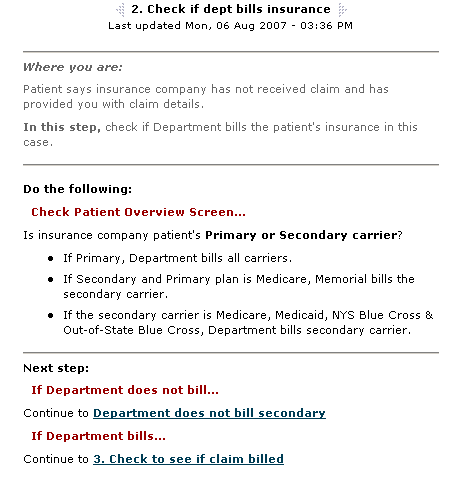 The
representative's goal is to serve the institution's patients by
answering and resolving any problems they are having with their
bills. In ASK PA the goal of the workflow is stated
clearly and representatives are guided through the correct
steps, branching where appropriate
based on the specific circumstances of the patient's query. The
instructions for each step place it within the context of previous
steps, make clear what should be done, and clarify under what
conditions this step should be
performed. The
representative's goal is to serve the institution's patients by
answering and resolving any problems they are having with their
bills. In ASK PA the goal of the workflow is stated
clearly and representatives are guided through the correct
steps, branching where appropriate
based on the specific circumstances of the patient's query. The
instructions for each step place it within the context of previous
steps, make clear what should be done, and clarify under what
conditions this step should be
performed.A sample middle panel with instructions for completing this step. Note the Where you are section to orient the rep to this step and the alternative paths depending on the patient's insurance. | |||
| 3. Minimizes terminology translation or interpretation. | |||
The terminology used in ASK
PA is consistent with both what the reps would know and what the
patient is
likely to understand. This makes it easier for the representative to
communicate complex rules, acronyms, and medical/insurance terminology
to an audience that is likely to have difficulty understanding them.
This is particularly important because the patients are often under
stress due to the nature of their medical illness.  The program also
contains a glossary, which the representative may use to help clarify
difficult terms or concepts even further. The program also
contains a glossary, which the representative may use to help clarify
difficult terms or concepts even further.A typical glossary entry | |||
| 4. Provides access to supporting and learning resources. | |||
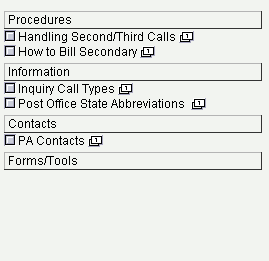 The principle behind ASK PA
is to provide a single page that simultaneously gives the reps: The principle behind ASK PA
is to provide a single page that simultaneously gives the reps:
A sample right-panel list of one-click links to relevant resources for the current step 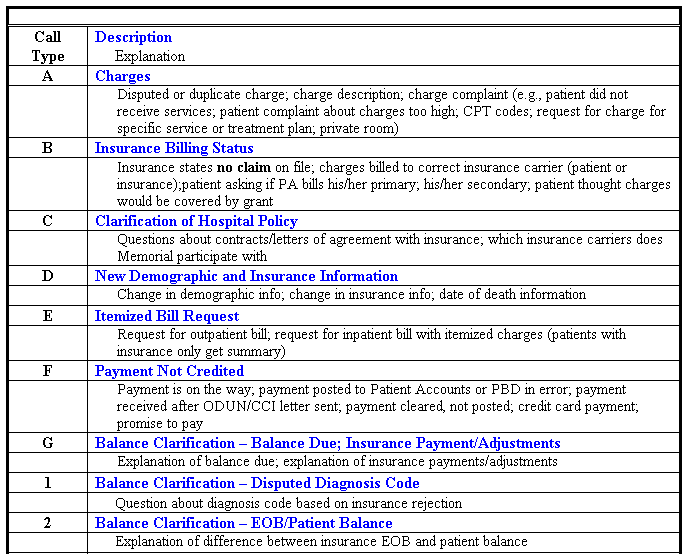 A sample resource: a list of codes that reps frequently reference, made instantly available | |||
| 5. Focuses on task(s), processes, and the natural flow of work. | |||
The
flow of the work is always visible through the hierarchal menu in the
left-hand panel of the screen. Representatives who are unfamiliar with
the workflow can easily follow it from beginning to the end. If the
representative has a question about how to proceed on a specific step
within the workflow, he or she can quickly click on that step to
display the instructions needed. Within the instructions for completing
each step are warnings to alert the representatives of potential
problems or to make sure that certain conditions apply before going
down a specific path.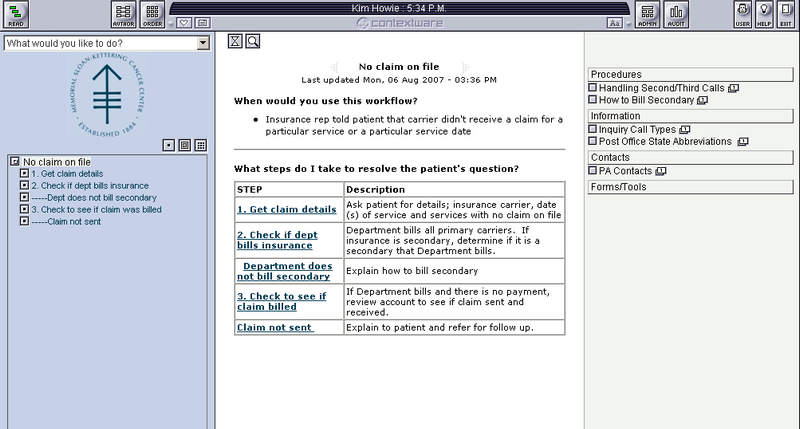 A sample opening page for a workflow. Note that ASK PA states the purpose of the flow and provides a summary of the steps. Continual use of ASK PA ensures that the representatives will eventually internalize the workflow and have less need to reference the workflows they have learned in this implicit manner--somewhat in the way a child learning to ride a bicycle eventually weans herself from a set of training wheels. But the reps can still return to ASK PA for quick access to the enabling resources. And, because they are continually alerted to changes to the workflows through the administrator's daily updates, reps will return to ASK PA to ensure they are following the latest instructions. | |||
| 6. Reduces or eliminates the need for training/learning. | |||
| The
structure of the content in ASK PA mimics the flow and the goals of the
work. This reduces the amount of cognitive effort needed to understand
and remember the flows and the steps within those flows. Consequently,
the use of the program continually reinforces the proper flow. After
the reps have used ASK PA a few times, the knowledge becomes
internalized. What they did not know before, they learn while doing. Because of the great importance the hospital places on serving its patients as effectively as possibly, and because the representatives' job demands a variety of skills specifically related to departmental procedures and insurance requirements, the department requires that new reps spend time becoming familiar and comfortable with the job before beginning to take live calls. ASK PA reduces that orientation period in several ways:
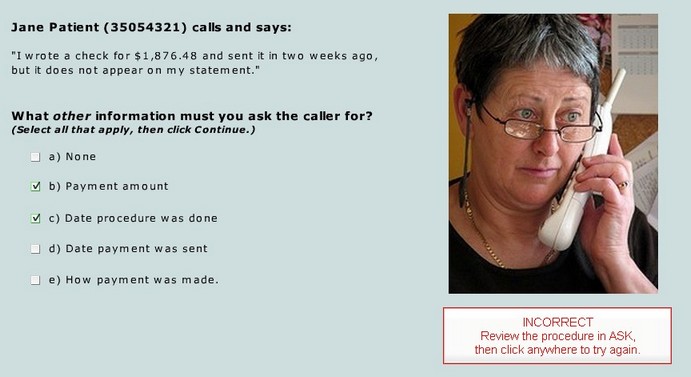 A sample page from a simulation of call flows. Note that the learner is directed to ASK for assistance. |
|||
| 7. Supports performance FIRST, and learning only as a secondary consequence of doing. | |||
ASK PA
exhibits all three essential elements of
performance:
|
|||
| 8. Is innovative with respect to supporting performance. | |||
ASK
PA is remarkable for its efficiency, both in presenting the precise
support needed at precisely the time it is needed and in its ability to
integrate and promote an ongoing high-performance environment.
Additional searching is not
required.
Nor is it necessary to have previously memorized any of the
instructions or resources in order to complete the task successfully.
| |||
| | |||
| Prior
State: (Required) |
Prior to the introduction of
ASK PA, reps learned how to handle patients’queries partially from a
formal training class and through informal observation and abbreviated
training sessions with the group’s Supervisor and Group Leader who also
had their own responsibilities to handle. Feedback from the staff
indicated that more individual sessions would have been preferable and
would have decreased their concerns about taking calls. Once on
the phones, reps generally turned to the Group Leader or Supervisor to
get answers to questions they had about the procedures. This meant
either putting the patient on hold and sometimes ending the call and
calling the patient back at a later time. They often asked other reps
for help as well. In addition, some reps would ask the same
question numerous times to be sure that they were doing the right thing. Without an official statement of the proper procedures and Best Practices, the reps might receive conflicting instructions. In those cases, calls of the same type were handled differently, increasing the chances that the patient would be given partial, or incorrect, information or all necessary follow-up actions might not be taken. In addition, when a rep put the patient on hold to get an answer from the Supervisor, patient satisfaction with the call center was reduced, contrary to the department’s and hospital’s goals. |
||
| | |||
| User
Profile: (Required) |
Inquiry Unit reps may have relevant experience within the hospital or a similar health care related organization, but there is no established channel from which new candidates are routinely selected. Historically, new reps require three to four months of orientation before taking live calls from patients. Currently, incumbent reps in the Inquiry Unit have from eight months to four years experience on the job. | ||
| | |||
| Results: (Required) |
Evidence gathered so far on
the results of the ASK PA initiative has been qualitative, gathered
through interviews with members of the Patient Accounts Department.
Among the responses:
|
||
| Other Evidence: | Reps report that they have far
greater confidence that they are giving the right information to their
patients, because they can validate their responses by checking the
content in ASK PA. Given the complexity of health care finance and
insurance reimbursement, there were times when they felt unsure if they
had handled a call correctly. Eliminating this uncertainty has made
their jobs less stressful. They appreciated being able to find answers
for themselves rather than continually asking for assistance from the
Supervisor or others. |
||